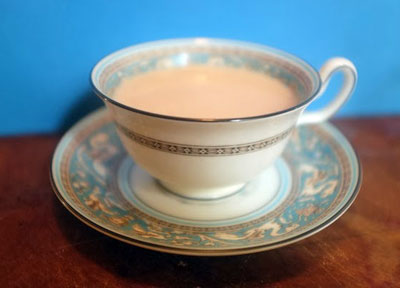 The other day I took a walk through Wally's, my local wine emporium's
autumn sale and was bottle shocked by the number of kosher wine choices
on display—Ninety-seven Jewtique labels. From Israel to Australia to
the Valley of Napa, there are rabbis rendering grapes right for Jewish
tables the world over.
The other day I took a walk through Wally's, my local wine emporium's
autumn sale and was bottle shocked by the number of kosher wine choices
on display—Ninety-seven Jewtique labels. From Israel to Australia to
the Valley of Napa, there are rabbis rendering grapes right for Jewish
tables the world over.
Although pleased as wine punch that my brethren can sip with
confidence from so many vineyards at all the holiday tables to come, I
felt drowned in a sudden wave of nostalgia, for, over in a less popular
corner, I spied some "Man Oh Manischewitz – What a Wine" languishing,
neglected for a mere $4.99 in its own dust.
And a flood of bittersweet tasting memories ensued…of my parentally
enforced Prohibition. The years of my youth when I was served Welch's
grape juice in a grown up glass at the holidays to placate my longing
for the real deal. I sipped the faux, while the elders were slurping
Manichevitz, the manna of the God, the only choice in that era, with
lip-smacking satisfaction. I'd lift my grape laced goblet, toast and
boast—'Lookit! Lookit how fast I can drink it!"
Food, Wine, Good (and Evil) Spirits
Food, Wine, Good (and Evil) Spirits
Vanilla Purr Cambric

The certified tea specialist and proprietor Christopher Coccagna made a number of wonderful drinks for Winter with tea and milk. Some of the drinks had alcohol in them and others didn't. Some used herbal teas and some used black teas. Some will definitely perk you up while others are perfect as a relaxing nightcap. There's really something for everyone, even kids and teetotalers. Check out the recipes for all kinds of luscious tea and milk drinks including Vanilla Mint Cambric, Lavender London Fog Latte and White Russian Caravan at GotMilk.
My Jones Soda
 What could be better than to customize the label on your soda? Well, yeah, world peace, but in the meantime, Jones Soda, which my daughter Lena turned me on to, has done that. Right from the beginning. In fact, they’ve gotten awards for their unique packaging and constantly changing labels, which are generated and submitted by their customers. Their attitude is clearly expressed by other product lines such as their energy drink: WhoopAss. This season you can give the gift of Holiday Collectors Packs. Be “thankful” Thanksgiving is over. They had Turkey and Gravy Flavor. Look out Bernie Botts.
What could be better than to customize the label on your soda? Well, yeah, world peace, but in the meantime, Jones Soda, which my daughter Lena turned me on to, has done that. Right from the beginning. In fact, they’ve gotten awards for their unique packaging and constantly changing labels, which are generated and submitted by their customers. Their attitude is clearly expressed by other product lines such as their energy drink: WhoopAss. This season you can give the gift of Holiday Collectors Packs. Be “thankful” Thanksgiving is over. They had Turkey and Gravy Flavor. Look out Bernie Botts.
Our Favorite Mardi Gras Cocktails
 No town knows how to celebrate like New Orleans. With parades and festivities going strong until next Tuesday, here are some classic libations from the Big Easy that will make your Mardi Gras celebration a night you won't remember.
No town knows how to celebrate like New Orleans. With parades and festivities going strong until next Tuesday, here are some classic libations from the Big Easy that will make your Mardi Gras celebration a night you won't remember.
Wine and (Grilled) Cheese: The Perfect Pairing
 Childhood fantasy: Coming home from school on a cold day and having a grilled American cheese sandwich with a bit of tomato soup. Adulthood fantasy: A prosciutto, manchego and mint pesto pear grilled cheese sandwich paired with a glass of Hirsh Pinot Noir. Who says that childhood fantasies are better?
Childhood fantasy: Coming home from school on a cold day and having a grilled American cheese sandwich with a bit of tomato soup. Adulthood fantasy: A prosciutto, manchego and mint pesto pear grilled cheese sandwich paired with a glass of Hirsh Pinot Noir. Who says that childhood fantasies are better?
Last Thursday, Peggy and I went to 3 Twenty Wine Lounge, our favorite wine bar, for the return of Campanile's grilled cheese night. Campanile was one of the great Los Angeles restaurants that for many years set the mark for food and style for dining in L.A. It original owners, Mark Peel and Nancy Silverton, were the foodie "it" couple. Reservations were impossible, food was incredible and the venue, once belonging to Charlie Chaplin, was gorgeous. Sadly, like many great restaurants, it ran its time and recently closed.
Of the many innovations that came from Chefs Peel and Silverton was the elevation of the grilled cheese sandwich to an art form. Many chefs today are making amazing grilled cheese – Celebrity Chef Eric Greenspan having twice won trophies at the international grilled cheese competition – but it was Peel and Silverton who started it all. They introduced a grilled cheese night at Campanile that was packed for years. It was the original. It still is the standard.
More Articles ...
Welcome to the new One for the Table ...
Our Home Page will be different each time you arrive.
We're sure you'll find something to pique your interest...

